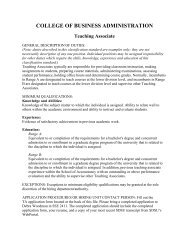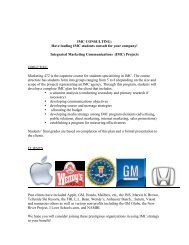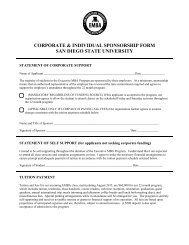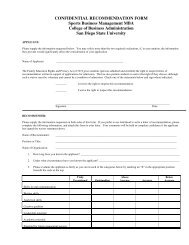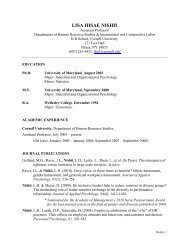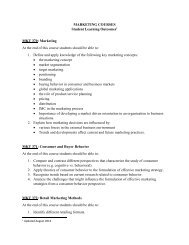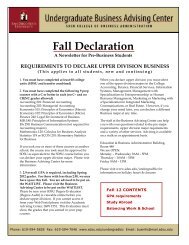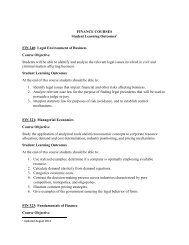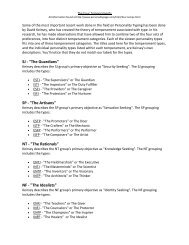2008 Report - The College of Business Administration
2008 Report - The College of Business Administration
2008 Report - The College of Business Administration
Create successful ePaper yourself
Turn your PDF publications into a flip-book with our unique Google optimized e-Paper software.
Student Learning Outcomes Committee <strong>2008</strong>Department/Program Assessment Results <strong>Report</strong>Department/Program School <strong>of</strong> AccountancyDate Submitted March 28, <strong>2008</strong>Degree/Program Masters (MSA)<strong>The</strong> purpose <strong>of</strong> this report is to communicate the assessment activities that have taken placeduring the last academic year, as well as to convey how the results are being used to improvestudent learning at the program level. <strong>The</strong> report should be kept as succinct as is possible,while answering the following questions clearly and conscientiously:I. Working from your assessment report <strong>of</strong> last year, please discuss some changes made orstrategies implemented in response to last year’s results.1. Writing Skills.a. <strong>The</strong> <strong>2008</strong>-09 catalog for the MSA has been changed to require as a prerequisite awriting/composition course from an English language university with a grade <strong>of</strong>B or better. Since there are a number <strong>of</strong> students in the pipeline, the results <strong>of</strong>this change have not yet been demonstrated in Acct 790, the capstone class wheresome international students with writing difficulties have the most problems.b. Two pr<strong>of</strong>essors held a special seminar in the fall for international studentsemphasizing the need for strong communication skills, both written and oral, inorder to progress in the program and meet the demands <strong>of</strong> the accountingpr<strong>of</strong>ession. <strong>The</strong>re were approximately 25 students in attendance.c. A handbook for MSA students was prepared to orient new students to theprogram. It included information on communication skills.d. For Fall <strong>2008</strong> admissions decisions, the department is creating a threshold VerbalScore on the Graduate Management Aptitude Test (GMAT). In the past acomposite verbal and math score <strong>of</strong> international students could create a highcomposite score which masked the student’s verbal abilities. In addition, thedepartment is considering ways to identify students with problems when theyarrive on campus the first semester. We also are attempting to reschedule forFall <strong>2008</strong> a first semester MSA class which in the past conflicted with a writingcourse in Linguistics.e. Current students now are being directed to writing assistance at the InternationalStudents Center and the Rhetoric and Writing Department. In addition, thissemester an instructor in the <strong>College</strong> <strong>of</strong> <strong>Business</strong> has provided some access totutors who were assigned to work with undergraduate business writing courses.2. Systems Program.a. In response to identified weaknesses in accounting information systems (AIS)<strong>of</strong>ferings, the department did the following:i. Developed two new courses, Acct 596 and 696 (AIS Development andAIS Audit and Control). Acct 596 first was <strong>of</strong>fered in Spg 2007. Acct 696is being <strong>of</strong>fered for the first time Spg <strong>2008</strong>.ii. <strong>The</strong> MSA program added a new AIS specialty track which incorporatesnot only Acct 596 and 696, but also courses from the IDS department inthe college.
II. Drawing upon the goals and objectives contained in the department/program studentlearning assessment plan, what was the focus <strong>of</strong> the department’s student learningassessment for the past academic year?A. This section should list the student learning goals and objectives that were the focus for thereport year (selected from your complete set <strong>of</strong> goals and objectives).Appendix A contains our complete set <strong>of</strong> Goals and Learning Outcomes.Appendix B contains our five year assessment plan.<strong>The</strong> focus for the past year was the following.GOAL 2: Acquire the ability to communicate effectively about accounting issuesLearning Outcomes:o Prepare oral and visual presentations for appropriate businessaudiencesB. It would also be helpful to note here the student learning goals and objectives that you intendto assess during the next year.GOAL 3: Acquire the capacity to address accounting problemsLearning Outcomes:o Apply ethical reasoning to accounting issuesIII. What information was collected, how much, and by whom?A. This section should briefly describe the methodology used to examine the targeted goals andobjectives. Please attach relevant scoring rubrics, surveys, or other materials used to examinestudent learning to the back <strong>of</strong> the report, as Appendices.1. Presentation EvaluationsEach student in Acct 790, the MSA capstone (a course taken at or near the end <strong>of</strong> theMSA program), prepares an oral report using PowerPoint. In Spg 2007, anassessment tool was developed to pilot test the instrument and assess the viability <strong>of</strong>using peer evaluations for assessment. <strong>The</strong> items on the instrument includeorganization, content, speaking characteristics, and visual aids factors. Students wereprovided with the rating instrument two weeks before the presentations were tobegin. <strong>The</strong> instructor discussed the expectations for the presentations and criteria forwhat would be considered acceptable skills. <strong>The</strong> discussion included references tospeakers at pr<strong>of</strong>essional meetings that the students are required to attend. On thefirst day <strong>of</strong> presentations, the instructor again discussed the ratings at the beginning<strong>of</strong> class. <strong>The</strong> same process was followed during Fall 2007 presentations. (AppendixC: Presentation Assessment)2. TA EvaluationsAnother measure <strong>of</strong> communication skills was taken <strong>of</strong> graduate students who teachintroductory accounting courses. <strong>The</strong> evaluation was done by the faculty memberwho mentors and oversees these students. <strong>The</strong> TA evaluation process involvesattending one class session for each TA and rating performance using a teachingperformance rubric. <strong>The</strong> rubric covers eleven teaching related competencies onwhich TAs are rated as “not acceptable,” “acceptable,” or “good.” Notes are madeon a separate page <strong>of</strong> the rubric about the teaching performance for each
competency, which are then used during a post evaluation meeting. <strong>The</strong> purpose <strong>of</strong>the post evaluation meeting is to discuss the TA’s teaching performance and how toimprove his or her skills. For example, there may be a discussion <strong>of</strong> how to moreeffectively/efficiently convey certain accounting topics or enhance the developmentand discussion <strong>of</strong> the material within the broader accounting context. <strong>The</strong> TAs areprovided with the rubric in advance so they have a chance to use it as a tool to helpguide their teaching as well as perform self-assessments before and after the in-classevaluation.(Appendix D: TA Evaluation Rubric)B. Please note that the expectation here is that programs will make use <strong>of</strong> direct measures <strong>of</strong>student learning outcomes.IV. What conclusions were drawn on the basis <strong>of</strong> the information collected?A. This section should briefly describe the results (in summary form) in regard to how well studentshave met the targeted goals and objectives. For example, what percentage <strong>of</strong> students met theobjectives? Is this a satisfactory level <strong>of</strong> performance? What areas need improvement?1. Presentation Evaluations<strong>The</strong>re were 21 students enrolled in Acct 790 in Spring 2007. Presented below is a graph,which compares the peer assessments with the instructor assessments. When presented tothe Assessment Committee, it was concluded that the use <strong>of</strong> peer assessments would beappropriate and should continue in the Fall.<strong>The</strong> instructor also observed a noticeable improvement in performance over prior semesters,especially with respect to the use <strong>of</strong> a distinct introduction and closing, and attention to thetime allocations. This improvement in the presentations could be attributed to severalfactors: 1) the discussion about the instrument and the communication objectives, and 2) thesimple fact that there was a measurement being made <strong>of</strong> these items.5.004.504.003.50Spring 2007 Assessments <strong>of</strong> Acct 790 Presentations, n=213.002.502.00Student Avg Spg 07Instructor Avg Spg 071.501.000.500.00A1 A2.2 A3.2 B1.2 B2.1 B2.3 C2<strong>The</strong> chart belowl shows the peer evaluations for Spring and Fall. <strong>The</strong>se results indicate aconsistent measurement range.
Comparison <strong>of</strong> Spring and Fall 2007 Peer Assessments, Spg 07 n=21; Fall 07, n=285.004.504.003.503.002.502.00Student Averages: Spg 07Student Averages: Fall 071.501.000.500.00A1 A2.1 A2.2 A3.1 A3.2 B1.1 B1.2 B1.3 B2.1 B2.2 B2.3 C1 C2<strong>The</strong> results indicate that the average peer ratings met the acceptable standard for all questions,i.e. all 28 students in Fall 2007 received an average rating <strong>of</strong> 3.0 or higher on all questions.<strong>The</strong> chart below examines the instructor’s ratings for Fall 2007. Looking at these ratings <strong>of</strong>students, the chart summarizes how many students met standards for each question. Whenviewing the average ratings received by category, 96% <strong>of</strong> the students received an averagerating from the instructor <strong>of</strong> 3 or higher for presentation qualities, 86% for speaking qualities,and 96% for the overall category. <strong>The</strong>re was a noticeably lower score on the eye contactvariable. <strong>The</strong> instructor observed that this was a result <strong>of</strong> several behaviors: reliance on notes,looking backward at the screen, and ignoring the people sitting on the borders <strong>of</strong> the room.Fall 07 Students Meeting Standards Per Instructor's Rating (N=28)PRESENTATION QUALITIESIntroduction Number PercentQ1 Clear, Sets the audience's expectations 28 100%BodyQ2 Content, clear & informative 28 100%Q3 Logical Organization & clear flow 28 100%ClosingQ4 Clear & Organized 26 93%Q5 Timed Appropriately 26 93%SPEAKING QUALITIESPhysical CharacteristicsQ6 Eye Contact- clear and direct, scans entire audience 18 64%Q7 Posture & Gestures - natural & definitive 25 89%Q8 Voice - tone, clarify & loudness 27 96%Visual Aids (PowerPoint)Q9 Organization 26 93%Q10 Effectiveness 26 93%Q11 Pr<strong>of</strong>essional appearance 27 96%OVERALLQ12 Effectiveness 27 96%Q13 Pr<strong>of</strong>essional image & presence 28 100%
2. TA Evaluations<strong>The</strong> data provided below represents some <strong>of</strong> the evaluations conducted over the pastthree semesters. We had not been tracking the evaluation data electronically becausethere wasn’t a direct need for it. So, the data used is simply what was in the files. Somedata was purged as people graduated or were no longer TAs. However, the availabledata does represent the evaluations for TAs during their first semester <strong>of</strong> teaching. Oncethis semester’s evaluations are complete, there will be some within-subjects data (i.e.,two semesters <strong>of</strong> data for some <strong>of</strong> the TAs). Since we now have a need to track this data,we will add to the data set each semester so we can provide more complete assessmentdata going forward. While the measurement <strong>of</strong> TA’s skills and competencies cannot begeneralized to the entire population, it is an important measure <strong>of</strong> oral communicationabilities in a subset <strong>of</strong> our student population; it also is a means for us to monitor andadjust the classroom environment for students who are taking our introductoryaccounting classes.As shown below, there was only one person who was evaluated as not acceptableduring the classroom visitation. <strong>The</strong> skills and competencies <strong>of</strong> the TA were not at alevel that would engage students in the topic. TAs with deficiencies are mentored aboutproblem areas, and those with significant problems are removed from the classroom.TA Evaluation RubricSummary statistics for the TA Evaluations 1Frequency Data for Each Rubric CategoryItem Not Acceptable Acceptable Good1 2 3% Rating 2 orAboveMeanScore 21 1 0 8 89% 2.78***2 0 2 7 100% 2.78***3 0 4 5 100% 2.56***4 0 0 9 100% 3.00***5 1 5 3 89% 2.226 0 5 4 100% 2.44**7 1 1 7 89% 2.67**8 0 0 9 100% 3.00***9 0 3 6 100% 2.67***10 0 3 6 100% 2.67***11 1 3 5 89% 2.441 Data are from evaluations conducted during the spring 2007, fall 2007 and, spring <strong>2008</strong>semesters.2 **, *** Significantly different from the midpoint <strong>of</strong> the scale (2) at p-value < 0.05,0.01, respectively; two-tailed.
B. Whenever it is possible to do so, please organize and present collected data by way <strong>of</strong> tablesand/or graphs. [Note: the committee expects and welcomes both quantitative and qualitativedata, so this suggestion should not be construed as seeking quantitative data only.]V. How will the information be used to inform decision-making, planning, and improvement?A. This section should describe the strategies that will be implemented for program improvement as a result <strong>of</strong>the conclusions drawn from the assessment activities.Presentation Evaluations:As a result <strong>of</strong> the positive effect <strong>of</strong> using presentation assessment forms in Acct 790, thispractice will continue each semester. Students benefit from a detailed discussion <strong>of</strong> theimportant elements in a presentation. In addition, when asked about the peerevaluations, students expressed a desire for them to continue because they receiveexplicit feedback from others on their presentations.TA Evaluations:As discussed above, in-class visitations in TA classroom will continue each semester,along with the appropriate levels <strong>of</strong> training and mentoring to enhance the educationalexperience. <strong>The</strong>se measures will result in the development <strong>of</strong> skills in both TA’s andundergraduate accounting students. Data will be retained and analyzed each semester.B. <strong>The</strong> program change may pertain to curricular revision, faculty development, student services, resourcemanagement, and/or any other activity that connects to student success.<strong>Report</strong> completed by: Pr<strong>of</strong>essor Carol F. VenableDate: March 28, <strong>2008</strong>
Appendix A: MSA Goals and Learning OutcomesMAJOR GOALS AND LEARNING OUTCOMES FOR THEM.S. ACCOUNTANCY PROGRAMGOAL 1: Obtain an understanding <strong>of</strong> current influences on and factors within the accountingpr<strong>of</strong>essionLearning Outcomes:o Assess the political, social, legal and regulatory environment <strong>of</strong> the pr<strong>of</strong>essiono Evaluate new developments effecting the pr<strong>of</strong>essionGOAL 2: Acquire the ability to communicate effectively about accounting issuesLearning Outcomes:o Express and defend reasoned opinion about accounting issueso Write well-organized memos and reportso Prepare oral and visual presentations for appropriate business audiencesGOAL 3: Acquire the capacity to address accounting problemsLearning Outcomes:o Analyze and research accounting related issueso Apply ethical reasoning to accounting issues
Appendix B: Five Year Assessment PlanASSESSMENT PLANSpring <strong>2008</strong> <strong>Report</strong>GOAL 2: Acquire the ability to communicate effectively about accounting issuesLearning Outcomes:o Prepare oral and visual presentations for appropriate business audiencesSpring 2009 <strong>Report</strong>GOAL 3: Acquire the capacity to address accounting problems.. Learning Outcomes:o Apply ethical reasoning to accounting issuesSpring 2010 <strong>Report</strong>GOAL 3: Acquire the capacity to address accounting problemsLearning Outcomes:o Analyze and research accounting related issuesSpring 2011 <strong>Report</strong> (Last reviewed in Spring 2007 <strong>Report</strong>)GOAL 1: Obtain an understanding <strong>of</strong> current influences on and factors within the accountingpr<strong>of</strong>essionLearning Outcomes:o Assess the political, social, legal and regulatory environment <strong>of</strong> the pr<strong>of</strong>essiono Evaluate new developments within the pr<strong>of</strong>essionSpring 2012 <strong>Report</strong> (Last reviewed in Spring 2007 <strong>Report</strong>)GOAL 2: Acquire the ability to communicate effectively about accounting issuesLearning Outcomes:o Express and defend reasoned opinion about accounting issueso Write well-organized memos and reports
Appendix C: Presentation Assessment DocumentPRESENTATION ASSESSMENTSpeaker:__________________________ Date_________________1 Needs Improvement– Significantdeficiencies that needwork2 Needs Enhancement– Problems or flawsthat detract from thepresentation3 Meets Standards-Demonstrates overallcompetence andacceptable skills4 Very Good –Demonstrates highquality andappropriate skills5 Outstanding –Exceeds what wouldbe expected in apr<strong>of</strong>essional settingPRESENTATION QUALITIESCIRCLE NUMBERIntroductionClear, sets the audience’s expectations 1 2 3 4 5BodyContent, clear & informative 1 2 3 4 5Logical organization & clear flow 1 2 3 4 5ClosingClear & organized 1 2 3 4 5Timed appropriately 1 2 3 4 5SPEAKING QUALITIESPhysical CharacteristicsEye Contact - clear and direct, scans entire audience 1 2 3 4 5Posture & gestures - natural & definitive 1 2 3 4 5Voice – tone, clarity & loudness 1 2 3 4 5Visual Aids (PowerPoint)Organization 1 2 3 4 5Effectiveness 1 2 3 4 5Pr<strong>of</strong>essional appearance 1 2 3 4 5OVERALLEffectiveness 1 2 3 4 5Pr<strong>of</strong>essional image & presence 1 2 3 4 5---------------------------------------------DUPLICATE TO TEAR OFF FOR STUDENT----------------------------------PRESENTATION QUALITIESIntroductionClear, sets the audience’s expectations 1 2 3 4 5BodyContent, clear & informative 1 2 3 4 5Logical organization & clear flow 1 2 3 4 5ClosingClear & organized 1 2 3 4 5Timed appropriately 1 2 3 4 5SPEAKING QUALITIESPhysical CharacteristicsEye Contact - clear and direct, scans entire audience 1 2 3 4 5Posture & gestures - natural & definitive 1 2 3 4 5Voice – tone, clarity & loudness 1 2 3 4 5Visual Aids (PowerPoint)Organization 1 2 3 4 5Effectiveness 1 2 3 4 5Pr<strong>of</strong>essional appearance 1 2 3 4 5OVERALLEffectiveness 1 2 3 4 5Pr<strong>of</strong>essional image & presence 1 2 3 4 5
Appendix D: TA Evaluation Rubric1234567TA Evaluated ______________________________________________Not Acceptable Acceptable Good1 2 3Although, the class session wasconducted well, it was not clear whatthe learning objectives were for thisclass session.It was never made clear what thelearning objectives were for today’sclass session.Class session plan was not wellorganized and appeared spontaneousand haphazard. <strong>The</strong>re didn't seem tobe a clear delivery plan.<strong>The</strong> presentation needed someexamples and most explanationswere difficult to follow.<strong>The</strong> instructor was not prepared anddid an inadequate job in explainingthe material<strong>The</strong> format <strong>of</strong> the presentation madeit difficult to stay focused on thetopic and to absorb any content.It seems as though the instructor didan inadequate job <strong>of</strong> putting thelecture material in context. It wasvery difficult to see how this materialfit into the context <strong>of</strong> the course.<strong>The</strong> technical competence <strong>of</strong> theinstructor is below expectations forthe course. Several errors werenoted in the presentation <strong>of</strong>accounting issues.I could follow the presentation, but itcould have been better organized<strong>The</strong> presentation did not use enoughexamples, and some <strong>of</strong> theexplanations were difficult to follow.<strong>The</strong> instructor stumbled occasionally,but appeared to be reasonablyprepared<strong>The</strong> format <strong>of</strong> the presentation madeit more entertaining and easier to stayfocusedThis instructor did a reasonable job inputting the lecture material in context<strong>of</strong> the course and/or accountingenvironment. More information,and/or more explanation, would havehelped.<strong>The</strong> technical competence <strong>of</strong> theinstructor was reasonably good.Only a few technical errors werenoted.At the start <strong>of</strong> class, the instructorgave a clear and concise overview <strong>of</strong>today’s topic(s)<strong>The</strong> presentation was very easy t<strong>of</strong>ollow. It was very well organizedand developed.<strong>The</strong> presentation used goodexamples with clear and conciseexplanations.<strong>The</strong> instructor seemed very wellprepared for their presentation<strong>The</strong> format chosen for thepresentation was very entertaining.It was an excellent way to presentthe material.This instructor did a very thoroughjob in developing their topic. <strong>The</strong>presentation contained an abundance<strong>of</strong> useful information.<strong>The</strong> presentation <strong>of</strong> accountingissues and/or procedures wastechnically accurate. No errors werenoticed.PointsAssigned8<strong>The</strong> instructor had annoyingmannerisms<strong>The</strong> instructor had few, if any,annoying mannerisms.<strong>The</strong> instructor did an excellent jobwith no annoying mannerisms91011<strong>The</strong> instructor had difficultyspeaking clearly and/or had poor eyecontact. Delivery was dry. Hard tostay focused on what was beingpresented.<strong>The</strong> instructor could never fullyengage the class on any <strong>of</strong> thesubjects covered. Class attentivenesswas poor.Overall, the class session was poorlyconceived and executed. It wasdifficult to stay focused.<strong>The</strong> instructor spoke clearly and hadgood eye contact, but the deliverywas somewhat dry.<strong>The</strong> instructor was not able tocontinuously engage the class.Attention <strong>of</strong> class would occasionallyflounder.Overall, the class session wasadequately planned and executed.<strong>The</strong> delivery was very clear andentertaining. Good eye contact, easyto hear, and good voice inflection.<strong>The</strong> instructor was able to effectivelyengage the class in dialog and/or raptattention.<strong>The</strong> class session was excellent. Itwas easy to stay focused.Total Points
Eval #Suggestions for TAComments1234567891011



